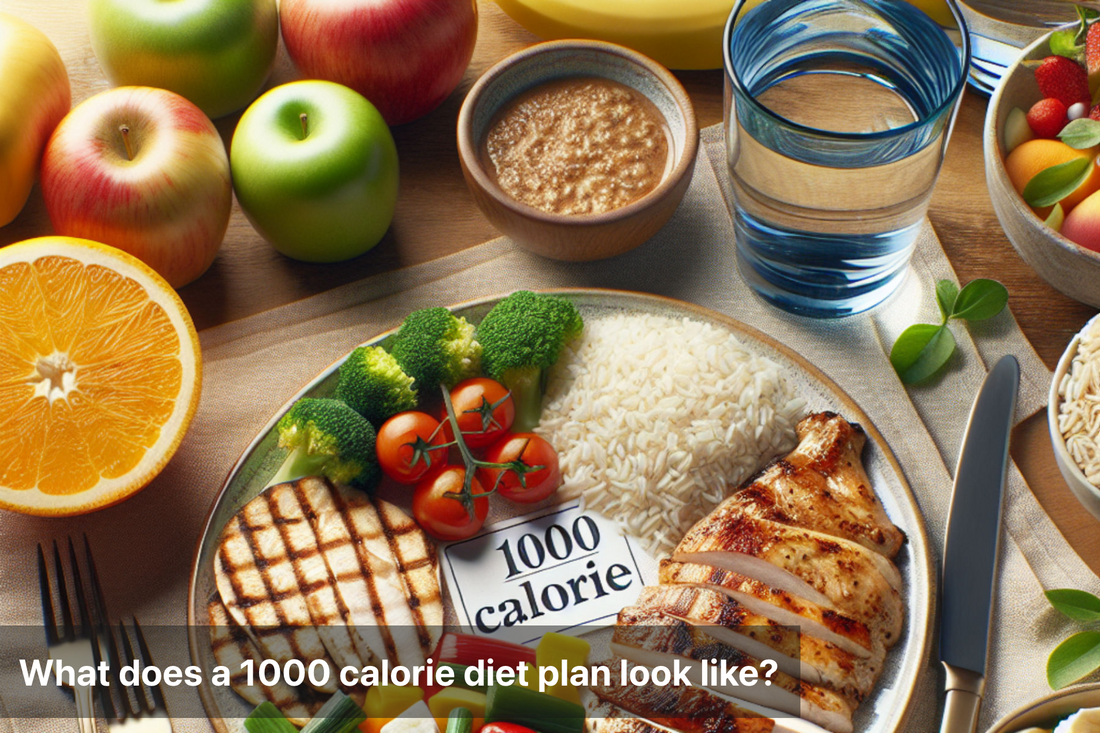
What does a 1000 calorie diet plan look like?
Share
When it comes to weight loss, portion control and calorie tracking are often top of mind. One of the most commonly discussed approaches is the 1000 calorie diet plan — a low-calorie strategy designed for quick, short-term results. But is it healthy? What does it actually look like on a plate? And how can you follow it while still getting the nutrients your body needs?
This guide breaks down everything you need to know about what a 1000 calorie diet looks like, along with a sample full-day plan, food swaps, safety considerations, and tips for sustainable success.
What Is a 1000 Calorie Diet?
A 1000 calorie diet restricts total daily energy intake to just 1000 kilocalories. It’s considered a very low-calorie diet (VLCD) and is usually recommended under medical supervision for people with obesity or those prepping for short-term fat loss goals. For the average adult, daily calorie needs range from 1600–2400 kcal, so this is a significant reduction.
While it can result in rapid weight loss, this plan is not suitable for long-term use unless advised and monitored by a healthcare professional. It must also be nutritionally balanced to avoid deficiencies.
Key Guidelines for a Healthy 1000 Calorie Diet
Prioritize high-protein, high-fiber foods to stay fuller longer
Include low-calorie vegetables in every meal for volume and vitamins
Choose lean proteins like eggs, tofu, chicken breast, or legumes
Use minimal oil, butter, and high-fat dressings
Avoid sugary drinks, processed snacks, and high-carb fillers
Stay hydrated with water, herbal teas, and black coffee
Consider a multivitamin if following the diet for more than a few days
Sample 1000 Calorie Diet Plan: Full-Day Meal Breakdown
Here’s what a sample day on a 1000 calorie diet could look like, covering all major food groups and maintaining satiety:
Breakfast (Approx. 250 kcal)
2 boiled eggs (140 kcal)
1 slice whole grain toast (70 kcal)
1 cup black coffee or green tea (0–5 kcal)
1 cucumber or tomato slice (10–20 kcal)
Mid-Morning Snack (Approx. 100 kcal)
1 small apple or orange (80 kcal)
A few almonds (4–5 pieces, ~20 kcal)
Lunch (Approx. 300 kcal)
1 cup cooked quinoa or brown rice (110–130 kcal)
¾ cup cooked mixed vegetables (50 kcal)
1 small grilled chicken breast or ½ cup paneer (100–120 kcal)
Lemon wedge and herbs for seasoning (0 kcal)
Evening Snack (Approx. 50 kcal)
1 cup unsweetened buttermilk or herbal tea (30 kcal)
1 small piece of dark chocolate (optional, ~20 kcal)
Dinner (Approx. 300 kcal)
1 bowl clear vegetable soup (60–80 kcal)
1 multigrain roti (80–100 kcal)
½ cup sautéed spinach or methi with garlic (60–80 kcal)
Small bowl cucumber raita or plain curd (40–60 kcal)
Total: ~1000 Calories
The goal is to combine volume with nutrient density, ensuring you're not starving but still staying within the limit.
Sample Ingredient Calorie Reference (Per 100g, Approx.)
Calories |
Protein |
Notes |
|
|---|---|---|---|
Boiled Egg |
68 kcal |
6.3g |
Excellent lean protein |
Cooked Quinoa |
120 kcal |
4.4g |
High in fiber, gluten-free |
Paneer (Low-fat) |
145 kcal |
11g |
Opt for grilled or steamed |
Cucumber |
16 kcal |
0.6g |
Adds bulk, almost zero cal |
Spinach (cooked) |
23 kcal |
2.9g |
Iron and fiber-rich |
Brown Rice (cooked) |
110 kcal |
2.5g |
Lower glycemic index than white rice |
Is a 1000 Calorie Diet Plan Safe?
This diet may be safe for:
Short-term fat loss goals
Those under medical or dietitian guidance
Sedentary individuals with low basal metabolic rates
Pre-operative dietary prep (as prescribed)
Not recommended for:
Active individuals or athletes
Children, teens, pregnant or breastfeeding women
Long-term weight loss without professional monitoring
Anyone with a history of eating disorders
Potential side effects of prolonged use include fatigue, dizziness, nutrient deficiency, and slowed metabolism. Always consult a healthcare provider before starting any VLCD.
Tips for Following a 1000 Calorie Plan Effectively
Track your meals using apps like MyFitnessPal to stay within limits
Plan ahead to avoid impulsive snacking
Batch cook soups, salads, and proteins for quick assembly
Avoid drinking your calories—stick to water, tea, or black coffee
Include fiber-rich foods to aid digestion and reduce cravings
Exercise moderately, such as walking or light yoga, to support energy balance
Smarter Food Swaps to Save Calories
Swap whole milk for unsweetened almond milk
Use sprouted moong instead of fried snacks
Replace sugary cereal with boiled eggs or Greek yogurt
Choose raw salads over creamy dips or chutneys
Use lemon, herbs, and spices for flavor instead of sauces or dressings
Benefits of a 1000 Calorie Plan (Short-Term)
Fast water weight and initial fat loss
Increases awareness of portion sizes and food habits
Helps break sugar addiction and mindless eating
Useful for kick-starting a larger fitness program
Summary
A 1000 calorie diet plan is a disciplined, low-intake approach best suited for short-term weight management under proper guidance. When done correctly, it emphasizes nutrient-rich foods, protein, and fiber while cutting down empty calories. By focusing on meal quality, smart portioning, and hydration, you can still eat satisfying meals while staying within this strict calorie window.






